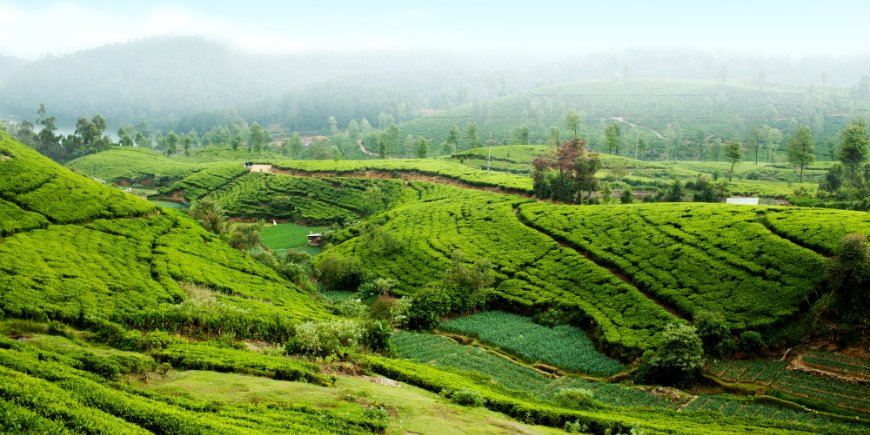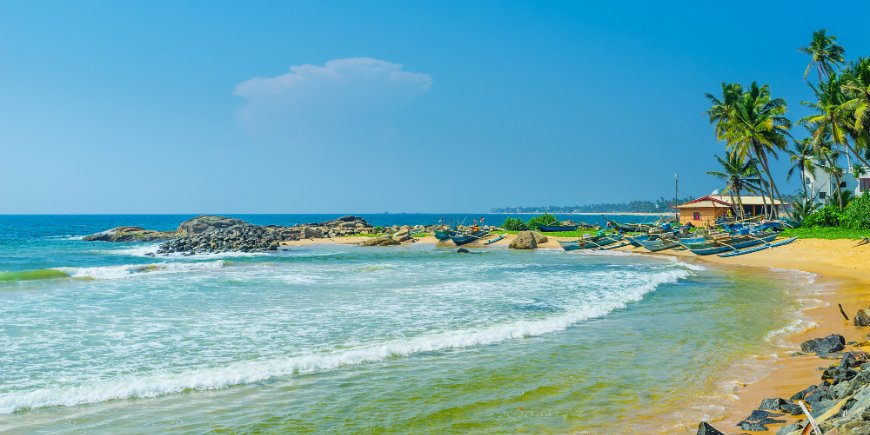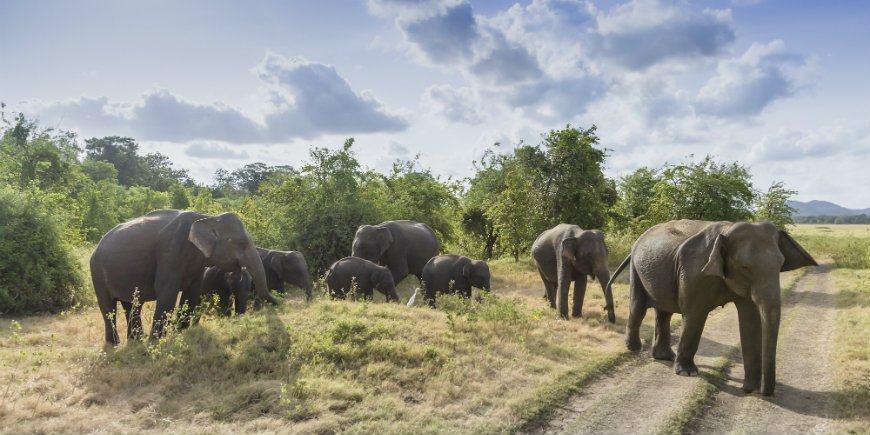When is the best time to visit Sri Lanka?
19.09.2017 | updated: 12.10.2022
In Sri Lanka, the beautiful island to the south-east of India, you will discover picturesque beaches, scenic tea plantations and locals with a zest for life. But when should you go there?
Read on below to find out when it’s the best time to visit the island.
Climate of Sri Lanka
Sri Lanka is a year-round destination.
Sri Lanka is situated in the tropical climate belt, which means that whatever the season, you can expect warm weather, with occasional rain like home. So, there really is no “bad” time to visit Sri Lanka.
However, Sri Lanka is made up of coastline and central highlands, and the weather varies accordingly. There are also two monsoons, which bring increased rain at different times in the south-west regions and the northern & eastern regions of Sri Lanka.
In general, you can expect it to be hotter by the coasts than in the central highlands, where you can experience cooler nights over the course of the year.
Monsoons of Sri Lanka

Sri Lanka has two monsoons, which create rainy seasons in their respective areas of Sri Lanka.
A monsoon is a seasonal shift in wind directions that can cause heavy rain in the areas affected by the monsoon.
There are two primary monsoons in Sri Lanka:
- The North-East Monsoon, or the Maha monsoon, strikes between December and February. The monsoon may affect the entire island, but it typically rains the most in northern and eastern parts of Sri Lanka.
- The South-West Monsoon, or the Yala monsoon, strikes between May and September. The South-West Monsoon is less intense and primarily affects the southern and western coasts, as well as the highlands.
Beyond the two primary monsoons, there are two intermediate periods:
- March & April, when rain primarily falls in the south-west and in the highlands
- October & November, when the weather may be unstable all over the country
As the two monsoons cause rain in different parts of Sri Lanka, there is always somewhere where the weather is drier. Note that even during the monsoon season, the showers are typically short, but powerful, and the weather often quickly clears up again.
Weather in Sri Lanka – month by month

January
January is generally a fantastic time to visit Sri Lanka, as it overwhelmingly offers sunny and relatively dry weather.
- In the northern and eastern regions of Sri Lanka, the North-East Monsoon blows.
- It is hot in the highlands, but expect cooler weather in the evening.
- In the southern and western parts of Sri Lanka, you can expect hot and relatively dry weather, however.
February
February remains a good month to visit Sri Lanka.
- The North-East Monsoon is in decline, so you can expect somewhat less rain in the north-eastern regions than in the previous months.
- The southern, western and central areas receive lots of sun and very little rain.
March
March is generally also a good month with nice weather in all of Sri Lanka.
- When you reach March, the North-East Monsoon is basically gone. This means that the temperatures start rising in the northern and eastern regions and the amount of rain decreases.
- On the southern and western coasts, the temperatures rise as well, but you must expect some rain towards the end of the month as the South-West Monsoon slowly approaches.
April
April is a hot and sunny month, and some argue that this is among the best months to visit Sri Lanka, as the North-East Monsoon is gone and the South-West Monsoon has not gotten started yet.
- In eastern Sri Lanka it will rain less than in the previous months, and you can expect blue skies and plenty of sunshine.
- In the southern and western areas, we are approaching the arrival of the South-West Monsoon, so the humidity is increasing. As May approaches, it begins to rain in southern, western and central Sri Lanka.
This is your last chance if you would to go on a whale safari from Mirissa on Sri Lanka’s south coast. The whale season lasts from October to April.
May
In May, the monsoons shift, and where the weather was primarily affected by the North-East Monsoon in the past months, the coming months will be affected by the South-West Monsoon to a greater degree.
- As we approach May, the weather on the west coast is getting truly nice. The temperatures are rising, the sun is shining, and there is very little rain. You may therefore do well to have your beach holiday here, such as at Trincomalee.
- In this period, the southern and western regions of Sri Lanka (e.g. Galle, Mirissa, Hikkaduwa and the highlands) will start to be affected by the South-West Monsoon, which slowly makes its approach. This means that there will be lots of sunshine, which are broken up by short, yet powerful showers.
June
June is in many ways a continuation of May when it comes to the weather.
- To the north and east, the weather is clear, sunny and dry, and spending your beach holiday here is still recommended.
- In the area around Sigiriya, you can expect high temperatures and minimal amounts of rain.
- The southern and western regions are still affected by the South-West Monsoon. This means more rain and lower temperatures. Despite the monsoon, it is not unusual for several days to pass without rain.
July
July offers comfortable temperatures all across the island. This is one of the best times to visit Minneriya National Park, as in the period from May to September, the elephants wander to the large lake in the park, Minneriya Tank, to drink water. This phenomenon is also known as “the Elephant Gathering”.
- The north and west coast remain hot and sunny, and a beach holiday at Trincomalee remain lovely.
- It is hot in central Sri Lanka, e.g. in Sigiriya. Note, however, that the evenings may still be chilly in the highlands, e.g. Around Kandy, Haputale, Ella and Nuwara Eliya.
- The South-West Monsoon can still affect beach areas on the west coast, e.g. Negombo. On the other hand, the weather begins to clear up in the southern and western areas as July moves forward.
August
Sri Lanka is also great in August.
- On Sri Lanka’s eastern and northern coast, the weather remains good, and you will be spoiled for choice when it comes to the coastal beach areas.
- • Even though the South-West Monsoon continues to blow on the southern and western regions, August may have less rain here than in the months before and after.
September
September offers very diverse weather, as we are approaching the second interim period, and Sri Lanka may face cyclones with rain and wind all across the island over the next couple of months.
- You will find the best weather on the east coast, which typically has its last month with truly nice weather before the North-East Monsoon approaches. Towards the end of the month, it may start to rain.
- The South-West Monsoon may still affect the regions to the south, west, as well as central Sri Lanka.
October
October offers rapidly changing weather and is one of Sri Lanka’s wettest months. We are still between the two monsoons, and thunderstorms may occur. On the other hand, October is outside the peak season, and there may be fewer visitors than usual.
- The weather remains nice on the northern and eastern coasts, but as the North-East Monsoon slowly begins to replace the South-West Monsoon, and the rain picks up.
- Accordingly, the South-West Monsoon disappears, meaning less rain. The south and west coast see some of the year’s highest temperatures.
On Sri Lanka’s south coast, the whale season just barely begins. You can go on a whale safari from Mirissa between October and April.
November
November, like October, is a transitional period between two monsoons, and the month is among the wettest in Sri Lanka. Towards the end of the month, the somewhat unstable weather that has been present the past few months stops.
- The North-East Monsoon approaches, and the North and East encounter more unstable weather.
- In the highlands, you can still expect a bit of rain with chilly evening and night-time hours.
- In the southern and western areas, there is an increase in the number of sunshine hours, which may be broken up by rain in-between.
December
In December, we have passed the middle period, and the North-East Monsoon is well under way.
- It starts with rain in the northern and eastern parts of Sri Lanka.
- On the other hand, this is an excellent time to visit the western and southern areas, as well as the highlands, which typically receive lots of sunshine and very little rain, though showers may always come.
So when is the best time?
The best time to visit Sri Lanka depends on what you would like to experience the most. As long as you make sure to bring appropriate clothing, Sri Lanka makes a fantastic destination to visit all year.
A lot of people choose to travel during the period from November to March, during our winter season. Christmas is especially popular, so if you wish to visit during the Christmas holiday, be sure to book in good time! If you want to avoid the high season, you should consider travelling to Sri Lanka outside this period, when the weather is still good, but there are fewer visitors.
Please note: The above guide to Sri Lanka’s climate is intended as a guideline and is subject to change. Always check the weather forecast before your tour and contact our travel consultants if in any doubt about when to travel.
TourCompass – From tourist to traveller
